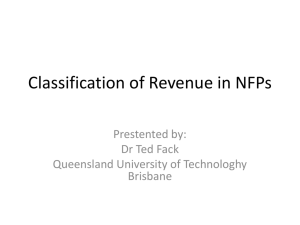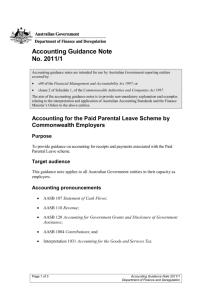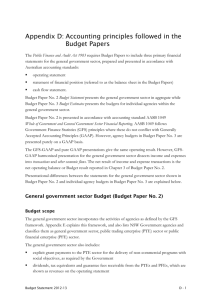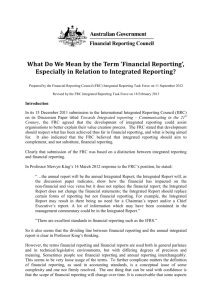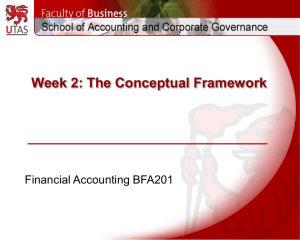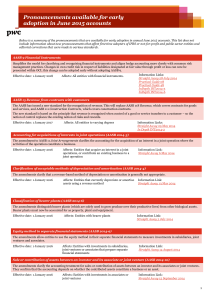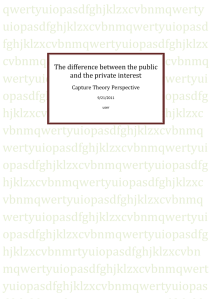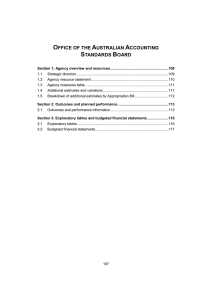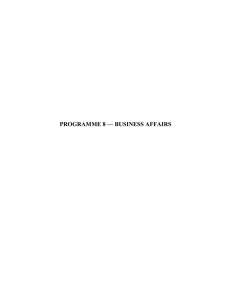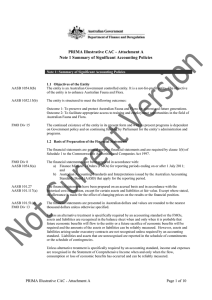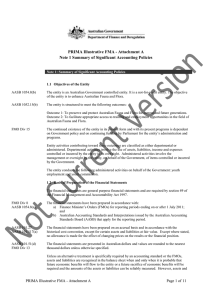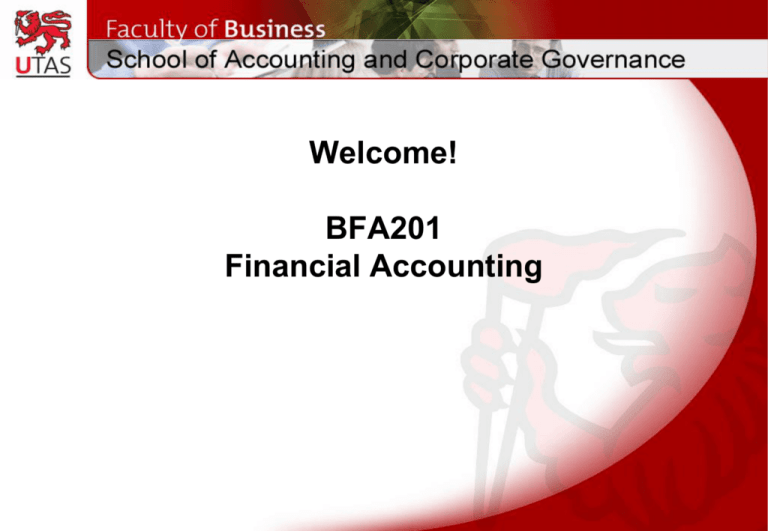
Welcome!
BFA201
Financial Accounting
Unit Outline
Financial Accounting BFA201
My Contact Details
• Steve Allen
– 64304578
– 0408358211
– Stephen.Allen@utas.edu.au
– @UTASCCC
3
4
Unit Outline
• Contact details
• Textbook
• Learning outcomes
• Prerequisite - BFA104
• Tutorial signup
• Self-study and tutorial questions
5
Unit Outline
• Attendance
• Assessment
• Penalties
• Referencing and plagiarism
• If you have a problem…
• Unit Schedule
6
Accounting Standards
• You will need to be familiar with the following websites (as
this saves you buying the Financial Reporting Handbook):
– http://www.aasb.gov.au
(AASB)
• Also useful:
– http://www.ifrs.org
– http://www.gaap.com.au
(IASB)
(GAAP)
7
Week 1: Overview of the
accounting reporting
environment
Financial Accounting BFA201
Learning Objectives
• To understand the Australian external financial reporting
environment
• Be able to explain the roles of ASIC, AASB, FRC, ASX, IASB
9
Readings & references
• Deegan (2012) Ch. 1
• Become familiar with AASB website – check if you can find
the accounting standards
10
Independent Study Tasks
• Read Chapter 1 of Deegan
• Access the AASB website and ensure you can find the
Accounting Standards
• Complete the following questions from Deegan (2012),
Chapter 1
• Review Questions 1 & 4
11
Financial Accounting Defined
• Financial accounting is a process involving the collection and
processing of financial information to assist the decision-making
needs of parties external to the organisation
• Contrasted with management accounting:
– focuses on providing information for decision-making by
parties within the organisation
– largely unregulated
• Financial accounting is heavily regulated
12
Special purpose v General Purpose Financial
Reports
• Special purpose financial reports are prepared to specifically satisfy the
financial information needs of a particular user (e.g. financial reports
prepared for a bank to support a loan application).
• Other parties might not have the necessary power to demand financial
reports that address their own information requirements.
• General purpose financial reports are developed to generally meet the
financial information requirements of a cross-section of shareholders as well
as other stakeholder groups (creditors, employees, government etc).
13
Users of General-purpose Financial
Reports
• Users may be defined to include:
– present and potential investors
– employees
– lenders
– suppliers and other trade creditors
– customers
– government and its agencies
– the public
• Users do not have the power to demand specific
information to meet their needs
14
Financial Accounting
• What is Financial Accounting?
– To provide useful information to users making decisions
about the allocation of scarce resources.
• GPFS v SPFS
• Who are the users of GPFSs?
15
Why Regulate Accounting?
• Separation of ownership & control
• Stewardship
• Accountability
• Complex organisations
• Use legislation & professional pronouncements
16
Accounting Regulators
1.
The Financial Reporting Council (FRC)
2.
The Australian Accounting Standards Board (AASB)
3.
The Australian Securities and Investments Commission (ASIC)
4.
The Australian Securities Exchange (ASX)
17
Financial Reporting Council
• Est. 2000 (CLERP 1999)
• Appointed by Treasurer
• Peak body
Federal Treasurer,
Hon Wayne Swan
• Oversees accounting & auditing
standard setting process
• Appoints members of AASB
• Advises government
18
www.aasb.gov.au
Functions:
•
Conceptual Framework
•
Accounting Standards
•
International Accounting Standards
•
Reports to FRC
19
Commonwealth Treasurer
Institutional
arrangements for
standard setting in
Australia
Auditing and
Assurance Standards
Board
Auditing and Assurance
Standards Board Staff
20
ASIC
•
Independent Government body
•
Administers Corporation legislation
–
Corporations Act:
–
Company directors; disclosing entities
–
Financial Statement preparation
–
‘True & fair’
•
Reports to Parliament & Treasurer
–
Note FRP (p. 12 Deegan) no longer exists
21
www.asx.com.au
•
One national stock exchange
•
1998 – publicly listed company
•
ASX Listing Rules
•
ASX Corporate Governance Council
22
Organisational structure for Australian accounting
standard setting
Source - http://www.aasb.gov.au/About-the-AASB/Organisational-structure.aspx
23
International Financial Reporting
Standards
•
2005 – Australia adopted IFRS
•
Corp Act – AASB makes standards
•
IFRSs are converted to AASBs
•
AIFRS
•
AASB Interpretations
•
More changes ahead – FASB (US)
24
AASB Standards
• 3 sources of AASB standards:
– AASB 1-99 series (new IFRS)
– AASB100-999 series (old IAS)
– AASB1000+ series (no international equiv.)
25
IASB www.iasb.org
•
Who are we & what do we do?
•
IASB creates IFRS
1.
2.
3.
4.
5.
•
Agenda
Discussion Paper
Exposure Draft (ED)
Adopted by countries
Two year review
AASB’s role in an IASB world
26
IFRIC
• International Financial Reporting Interpretations Committee
• Established Dec 2001, sub-committee of IASB
• Has the task of reviewing widespread accounting issues within
the context of current IFRSs
27
What is IFRIC?
International Financial Reporting Interpretations Committee
Ruth Picker
Managing Partner
Ernst & Young Melbourne
28
Points to Ponder
•
International cultural differences
•
All this regulation—is it really necessary?
•
Free-market perspective
•
Pro-regulation perspective
29
Next Week - Topic 2:
The Conceptual Framework and Fair Value
Measurement
Copyright notice
© Copyright University of Tasmania, School of Accounting & Corporate
Governance
All rights reserved.
Commonwealth of Australia Copyright Regulations 1969 - WARNING
This material has been reproduced and communicated to you by or on behalf of the University of
Tasmania pursuant to Part VB of the Copyright Act 1968 (the Act). The material in this communication
may be subject to copyright under the Act. Any further reproduction or communication of this material
by you may be the subject of copyright protection under the Act. Do not remove this notice.
30

